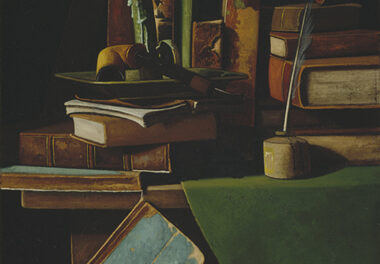It was the last of the first as Bechtler Museum of Modern Art presented the final First Tuesday concert of the 2012-13 Season, featuring a fine faculty sextet from the University of North Carolina School of the Arts in an appealing program of modern chamber works by composers whose names might prove daunting to some. The concert was more sparsely attended than any of the evening performances I’d previously reviewed in this year’s series, but our host, Bechtler president John Boyer, assured us that the program of Prokofiev, Shostakovich, and Bartók had drawn a full house earlier in the day for the lunchtime performance. Perhaps it was the local weather forecasts that had thinned our crowd, because a healthy downpour had my wife Sue and I lingering in the Bechtler lobby with the post-concert hors d’oeuvres before venturing to our car.
Upstairs on the fourth floor, the concert had begun with all six UNCSA emissaries playing Prokofiev’s Overture on Hebrew Themes. Parts were distributed unusually evenly between Dmitri Shteinberg at the piano; John Sadak, clarinet; Janet Orenstein, first violin; Jacqui Carrasco, second violin; Sheila Brown, viola; and Brooks Whitehouse, cello. Sadak was the main instigator of the pulsating, freilach-flavored first theme with Brown playing a surprisingly prominent role on the viola. As we slackened into a more wistful second theme, the violins and the cello carried most of the burden, so the return to good humor with Sadak’s clarinet taking the lead had a beguiling freshness with Brown still quite assertive. Whitehouse had an eloquent lament, echoed by Orenstein, as the music took another melancholy turn, but it was Orenstein with a long sustained note underneath Sadak’s mischievous reprise that ushered in the last madcap episode, gaining speed, intensity, and wild klezmer-like celebration as it concluded.
Shteinberg, Orenstein, and Whitehouse returned with a more complex mix of moods in Shostakovich’s Piano Trio No. 2, a piece that quickly rewards watching. Contrary to what the opening Andante sounds like on record, the aching Hebraic lament – or so it felt after the Prokofiev – was started by Whitehouse, playing harmonics on the cello, hovering over Orenstein’s violin when it entered with the same sad tune. Shteinberg completed the dolorous little fugue by entering, low into the bass clef, with the same theme when the first notes Whitehouse had played could already be forgotten. Listlessly the fugal trio forged on until it terminated in pulsing waves of sound that increased in tempo and anguish as Shteinberg accelerated into a second episode that straddled hope and sadness. Then Orenstein steered us into a region so familiar to us through Shostakovich’s symphonies, where anger is indistinguishable from insane celebration.
Orenstein was even more virtuosic at the start of the ensuing Allegro, a twisted scherzo with insistent pounding from Shteinberg that sounded more like earnest repetitive industry than festive celebration, almost a mockery of ignorant peasant jollity. Shteinberg brilliantly took over this runaway frolic until its climax, and then introduced the Largo with solemn block chords, yielding to Orenstein as she announced the dejected theme. Whitehouse’s response on cello was mellower, more resigned, more deeply heartbroken, but when the strings intermingled, the aching despair was even further heightened. Without a pause, Shteinberg led us stealthily into the astonishing Allegretto finale with a quiet vamp, joined by an impish pizzicato from Orenstein that might have been inspired by vaudeville. There was more mischief from Whitehouse, strumming on the cello as Shteinberg propelled us into a louder, more overtly merry episode. With all three instruments sometimes veering off into different directions, the movement ultimately coalesced into a manic march, colored with a dance motif as Hebraic as any of those in the preceding Prokofiev. This kaleidoscope of moods, after soaring in Shostakovich’s patented mix of anguish and jubilation, subsided into a solemn, reflective whimper.
After such a mighty performance, it was remarkable that Shteinberg, Orenstein, and Sadak were able to follow up with Bartók’s Contrasts for Violin, Clarinet, and Piano without it sounding anticlimactic. Nobody mentioned its starry origin when, in 1938, the great violinist Joszef Szigeti convinced jazz great Benny Goodman to commission a new piece from the Hungarian composer that the three of them premiered, in its final three-movement form, at Carnegie Hall in 1940. Even before it began, the piece was intriguing as both Orenstein and Sadak brought two instruments with them. The first of the three movements, a “Recruiting Dance,” had a loping beginning similar to the Shostakovich finale, only this time it was Orenstein doing the strumming, to banjo-like effect. Reaching maximum intensity, the dance sounded more like a march, lively but not enticing as a recruitment tool, conspicuously militaristic. Before the quiet resolution, Sadak excelled in a fevered cadenza that must have convinced Goodman he was getting his money’s worth. The middle movement “Relaxation” piece was the last that Bartók wrote for this commission, very characteristic in its spooky contrapuntal dissonances and more of a showcase for Orenstein, who ended the brief Largo plucking pizzicatos while bowing her instrument.
There was plenty of opportunity for all three musicians to shine in the final “Fast Dance,” but Orenstein and Sadak continued to steal the scene from Shteinberg by playing two instruments each during the frantic romp. The sour sounds produced by the violinist establishing the initial hoedown flavor of the Allegro vivace requires a mistuned instrument, but Orenstein also had the mad cadenza here on her normal instrument. Sadak wasn’t totally eclipsed, switching between his clarinets on four occasions and layering onto Orenstein’s cadenza with some virtuosic frenzy of his own. A huge cacophonous build seemed headed for an impossible stratosphere when it suddenly crashed into silence, the last deep breath before the comically raucous resolution.











